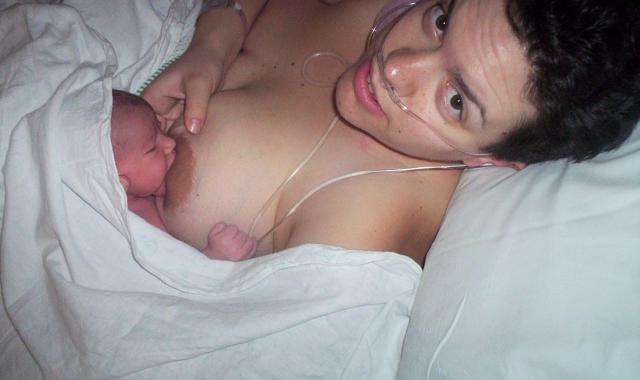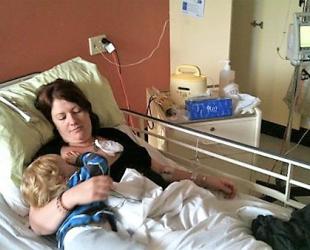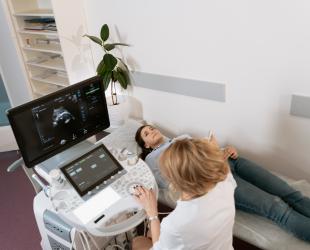Practical advice for breastfeeding mums when you or your baby need surgery.

If you or your baby are getting ready for surgery, you might be wondering how anaesthesia will affect breastfeeding. This guide will help you plan ahead and know what to expect, so you can keep breastfeeding safely.
Let your healthcare team know you’re breastfeeding, or that your baby is breastfed. Your surgeon and anaesthetist need this information to give you the best advice. They’ll tell you how long you or your baby need to fast before surgery, and when it’s safe to breastfeed again.
For a breastfed baby or child
Before surgery
Different times are usually given for breastmilk, formula, solid foods and clear fluids. The Australian and New Zealand College of Anaesthetists (ANZCA) recommendations:
- Babies under 6 months can continue to have breastmilk up to 3 hours before anaesthesia.
- Babies 6 months or older can have breastmilk up to 6 hours before anaesthesia. Clear fluids may be given up to one hour before.
Make a plan with your care providers so everyone knows when your baby can breastfeed. It is important that you do not fast them for longer than the recommended times.
If your baby needs to fast, it may help if a partner, family member, or trusted friend comforts them during this time. Older babies and toddlers can often be distracted until their operation.
After your child’s surgery
If your child is having a minor procedure and is otherwise healthy, you can usually breastfeed as soon as they’re awake. Toddlers may feel worried or confused after anaesthesia so a breastfeed can be calming and soothing.
For a mum who is breastfeeding
Before surgery
Again, let your healthcare team know you’re breastfeeding. This helps them choose medications that are safe for you. If your doctor isn’t sure, ask them to check with medicine information experts.
You’ll likely need to fast before your procedure. Your healthcare team will let you know when to stop eating and drinking, and whether you can have clear fluids up until a certain time.
If you’re breastfeeding, you might be especially aware of staying hydrated. For short procedures or mild anaesthesia, this usually isn’t a concern. But if your surgery is longer, you may want to ask your healthcare team about ways to keep hydrated, as this can help you feel more comfortable and support your milk supply.
If you’ll be separated from your baby for one or more feeds, you could express and store some milk ahead of time. This can be used to feed your baby while you’re apart.
Breastfeeding after surgery
Most anaesthetics and pain relief drugs pass into breastmilk at very low levels and aren’t thought to pose a risk to babies and young children. There’s usually no need to “pump and dump” your breastmilk. If your baby is premature or sick, or you’re taking strong pain medications, you may need extra care. Discuss your personal plan with your doctors.
After you wake up, you may feel drowsy or nauseous. You might need support to hold and breastfeed your baby safely. Ask a partner, family member, or friend to help you as you recover. If you’re in pain or feeling stressed, you might notice it’s harder for your milk to flow. This is because oxytocin, a hormone that helps with your let-down reflex, can be affected by stress or discomfort. Talk to your healthcare team about pain relief options, and ask for support if you need it.
If you’re not well enough to breastfeed, expressing can help keep your breasts comfortable and help maintain your supply.
Local anaesthesia
If you need a procedure on a small area of your body, your doctor, dentist or dermatologist may use a local anaesthetic. There’s no need to stop breastfeeding or throw away expressed milk after a local anaesthetic. Local anaesthetics are commonly used during and after childbirth, and there’s no evidence of harm to breastfed babies.
When there's no time to plan
If you or your baby need urgent surgery, there may be little time to prepare. This can disrupt breastfeeding and may cause a temporary drop in your milk supply. Many mums and babies go on to resume breastfeeding and rebuild their supply as soon as they’re well enough. If you need support, talk to a breastfeeding counsellor.
Further information
Patient information pamphlets about anaesthesia are published by the Australian Society of Anaesthetics.
The information on this website does not replace advice from your health care providers.
© Australian Breastfeeding Association December 2025
The following references were used to inform this article. They provide similar guidelines and recommendations on breastfeeding and anaesthesia.
Australian and New Zealand College of Anaesthetists (ANZCA). (2021). PG07(A) Guideline on pre-anaesthesia consultation and patient preparation. https://www.anzca.edu.au/getContentAsset/d4eb4cab-69e6-4228-8568-bbc911c6c505/80feb437-d24d-46b8-a858-4a2a28b9b970/PG07-Pre-anaesthesia-consultation-2024.pdf?language=en
Frykholm, P., Schindler, E., Sümpelmann, R., Walker, R., & Weiss, M. (2018). Preoperative fasting in children: Review of existing guidelines and recent developments. British Journal of Anaesthesia, 120(3), 469-474. https://doi.org/10.1016/j.bja.2017.11.080
The Academy of Breastfeeding Medicine. (2012). ABM Clinical Protocol #25: ABM Clinical Protocol #25: Recommendations for preprocedural fasting for the breastfed Infant: ‘‘NPO’’ Guidelines. Breastfeeding Medicine, 7(3), 197-202. https://doi.org/10.1089/bfm.2012.9988
Mitchell, J., Jones, W., Winkley, E. Kinsella, S.M. and the Association of Anaesthetists. (2020). Guideline on anaesthesia and sedation in breastfeeding women 2020. Anaesthesia, 75(11), 1482-1493. https://doi.org/10.1111/anae.15179
Westmead Hospital Women’s and Newborn Health. (2016). WSP-509 Breastfeeding and having surgery (v2) [Fact sheet]. Western Sydney Local Health District, New South Wales Government. https://www.wslhd.health.nsw.gov.au/ArticleDocuments/1371/WSP-509%20Breastfeeding%20and%20having%20surgery%202.pdf.aspx
Reece-Stremtan, S., Campos, M., Kokajko, L. and The Academy of Breastfeeding Medicine (2017). ABM Clinical Protocol #15: Analgesia and anesthesia for the breastfeeding mother. Breastfeeding Medicine, 12(9), 500-506. https://doi.org/10.1089/bfm.2017.29054.srt
American Society of Anesthesiologists. (2024). Statement on resuming breastfeeding after anesthesia. https://www.asahq.org/standards-and-practice-parameters/statement-on-resuming-breastfeeding-after-anesthesia
Uvnäs Moberg, K., Ekström-Bergström, A., Buckley, S., Massarotti, C., Pajalic, Z., Luegmair, K., Kotlowska, A., Lengler, L., Olza, I., Grylka-Baeschlin, S., Leahy-Warren, P., Hadjigeorgiu, E., Villarmea, S., & Dencker, A. (2020). Maternal plasma levels of oxytocin during breastfeeding - A systematic review. PloS One, 15(8), e0235806. https://doi.org/10.1371/journal.pone.0235806
Ueda, T., Yokoyama, Y., Irahara, M., & Aono, T. (1994). Influence of psychological stress on suckling-induced pulsatile oxytocin release. Obstetrics and Gynecology, 84(2), 259–262.


